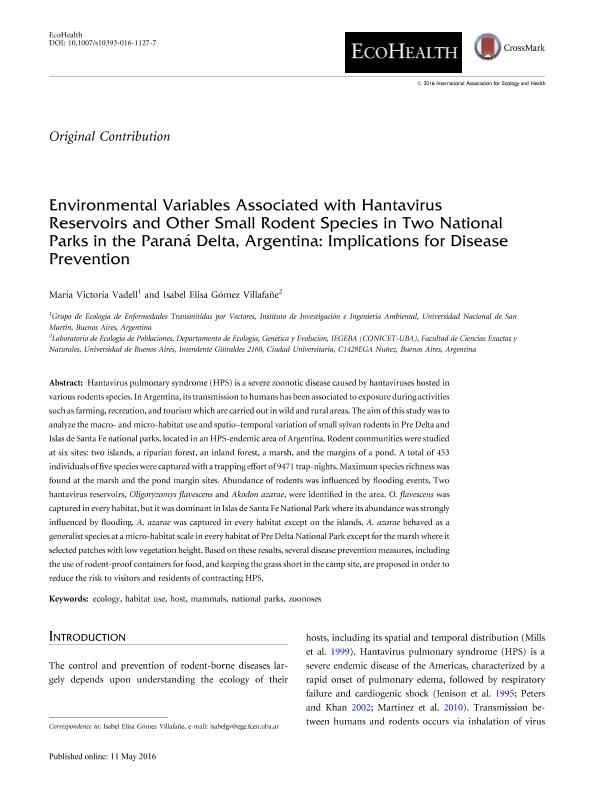Mostrar el registro sencillo del ítem
dc.contributor.author
Vadell, María Victoria

dc.contributor.author
Gomez Villafañe, Isabel Elisa

dc.date.available
2018-06-05T14:44:42Z
dc.date.issued
2016-05
dc.identifier.citation
Vadell, María Victoria; Gomez Villafañe, Isabel Elisa; Environmental variables associated with hantavirus reservoirs and other small rodent species in two national parks in the Paraná delta, Argentina: Implications for disease prevention; Springer; Ecohealth; 13; 2; 5-2016; 248-260
dc.identifier.issn
1612-9202
dc.identifier.uri
http://hdl.handle.net/11336/47307
dc.description.abstract
Hantavirus pulmonary syndrome (HPS) is a severe zoonotic disease caused by hantaviruses hosted in various rodents species. In Argentina, its transmission to humans has been associated to exposure during activities such as farming, recreation, and tourism which are carried out in wild and rural areas. The aim of this study was to analyze the macro- and micro-habitat use and spatio–temporal variation of small sylvan rodents in Pre Delta and Islas de Santa Fe national parks, located in an HPS-endemic area of Argentina. Rodent communities were studied at six sites: two islands, a riparian forest, an inland forest, a marsh, and the margins of a pond. A total of 453 individuals of five species were captured with a trapping effort of 9471 trap-nights. Maximum species richness was found at the marsh and the pond margin sites. Abundance of rodents was influenced by flooding events. Two hantavirus reservoirs, Oligoryzomys flavescens and Akodon azarae, were identified in the area. O. flavescens was captured in every habitat, but it was dominant in Islas de Santa Fe National Park where its abundance was strongly influenced by flooding. A. azarae was captured in every habitat except on the islands. A. azarae behaved as a generalist species at a micro-habitat scale in every habitat of Pre Delta National Park except for the marsh where it selected patches with low vegetation height. Based on these results, several disease prevention measures, including the use of rodent-proof containers for food, and keeping the grass short in the camp site, are proposed in order to reduce the risk to visitors and residents of contracting HPS.
dc.format
application/pdf
dc.language.iso
eng
dc.publisher
Springer

dc.rights
info:eu-repo/semantics/openAccess
dc.rights.uri
https://creativecommons.org/licenses/by-nc-sa/2.5/ar/
dc.subject
Hantavirus
dc.subject
Environmental Factors
dc.subject
Habitat Use
dc.subject
National Parks
dc.subject
Reservoirs
dc.subject
Rodents
dc.subject
Ecology
dc.subject.classification
Otras Ciencias Biológicas

dc.subject.classification
Ciencias Biológicas

dc.subject.classification
CIENCIAS NATURALES Y EXACTAS

dc.title
Environmental variables associated with hantavirus reservoirs and other small rodent species in two national parks in the Paraná delta, Argentina: Implications for disease prevention
dc.type
info:eu-repo/semantics/article
dc.type
info:ar-repo/semantics/artículo
dc.type
info:eu-repo/semantics/publishedVersion
dc.date.updated
2018-05-28T14:41:43Z
dc.identifier.eissn
1612-9210
dc.journal.volume
13
dc.journal.number
2
dc.journal.pagination
248-260
dc.journal.pais
Alemania

dc.journal.ciudad
Berlín
dc.description.fil
Fil: Vadell, María Victoria. Consejo Nacional de Investigaciones Científicas y Técnicas; Argentina. Universidad Nacional de San Martín. Instituto de Investigaciones e Ingeniería Ambiental. Laboratorio de Ecología de Enfermedades Transmitidas por Vectores; Argentina
dc.description.fil
Fil: Gomez Villafañe, Isabel Elisa. Consejo Nacional de Investigaciones Científicas y Técnicas. Oficina de Coordinación Administrativa Ciudad Universitaria. Instituto de Ecología, Genética y Evolución de Buenos Aires. Universidad de Buenos Aires. Facultad de Ciencias Exactas y Naturales. Instituto de Ecología, Genética y Evolución de Buenos Aires; Argentina. Universidad de Buenos Aires. Facultad de Ciencias Exactas y Naturales. Departamento de Ecología, Genética y Evolución. Laboratorio de Ecología de Poblaciones; Argentina
dc.journal.title
Ecohealth

dc.relation.alternativeid
info:eu-repo/semantics/altIdentifier/doi/http://dx.doi.org/10.1007/s10393-016-1127-7
dc.relation.alternativeid
info:eu-repo/semantics/altIdentifier/url/https://link.springer.com/article/10.1007%2Fs10393-016-1127-7
Archivos asociados
